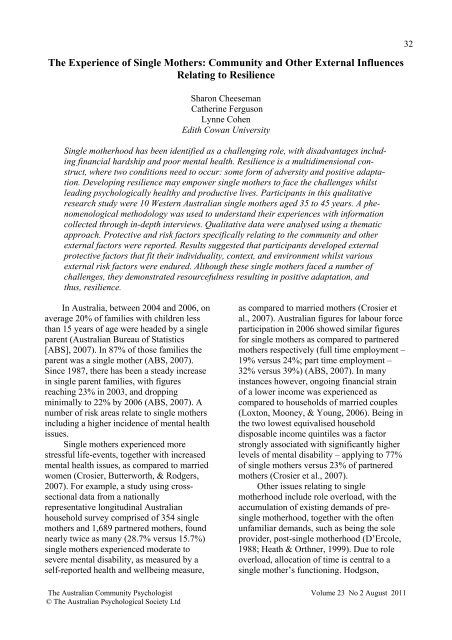The Australian Community Psychologist - APS Member Groups
The Australian Community Psychologist - APS Member Groups
The Australian Community Psychologist - APS Member Groups
You also want an ePaper? Increase the reach of your titles
YUMPU automatically turns print PDFs into web optimized ePapers that Google loves.
<strong>The</strong> Experience of Single Mothers: <strong>Community</strong> and Other External Influences<br />
Relating to Resilience<br />
Sharon Cheeseman<br />
Catherine Ferguson<br />
Lynne Cohen<br />
Edith Cowan University<br />
Single motherhood has been identified as a challenging role, with disadvantages including<br />
financial hardship and poor mental health. Resilience is a multidimensional construct,<br />
where two conditions need to occur: some form of adversity and positive adaptation.<br />
Developing resilience may empower single mothers to face the challenges whilst<br />
leading psychologically healthy and productive lives. Participants in this qualitative<br />
research study were 10 Western <strong>Australian</strong> single mothers aged 35 to 45 years. A phenomenological<br />
methodology was used to understand their experiences with information<br />
collected through in-depth interviews. Qualitative data were analysed using a thematic<br />
approach. Protective and risk factors specifically relating to the community and other<br />
external factors were reported. Results suggested that participants developed external<br />
protective factors that fit their individuality, context, and environment whilst various<br />
external risk factors were endured. Although these single mothers faced a number of<br />
challenges, they demonstrated resourcefulness resulting in positive adaptation, and<br />
thus, resilience.<br />
32<br />
In Australia, between 2004 and 2006, on<br />
average 20% of families with children less<br />
than 15 years of age were headed by a single<br />
parent (<strong>Australian</strong> Bureau of Statistics<br />
[ABS], 2007). In 87% of those families the<br />
parent was a single mother (ABS, 2007).<br />
Since 1987, there has been a steady increase<br />
in single parent families, with figures<br />
reaching 23% in 2003, and dropping<br />
minimally to 22% by 2006 (ABS, 2007). A<br />
number of risk areas relate to single mothers<br />
including a higher incidence of mental health<br />
issues.<br />
Single mothers experienced more<br />
stressful life-events, together with increased<br />
mental health issues, as compared to married<br />
women (Crosier, Butterworth, & Rodgers,<br />
2007). For example, a study using crosssectional<br />
data from a nationally<br />
representative longitudinal <strong>Australian</strong><br />
household survey comprised of 354 single<br />
mothers and 1,689 partnered mothers, found<br />
nearly twice as many (28.7% versus 15.7%)<br />
single mothers experienced moderate to<br />
severe mental disability, as measured by a<br />
self-reported health and wellbeing measure,<br />
as compared to married mothers (Crosier et<br />
al., 2007). <strong>Australian</strong> figures for labour force<br />
participation in 2006 showed similar figures<br />
for single mothers as compared to partnered<br />
mothers respectively (full time employment –<br />
19% versus 24%; part time employment –<br />
32% versus 39%) (ABS, 2007). In many<br />
instances however, ongoing financial strain<br />
of a lower income was experienced as<br />
compared to households of married couples<br />
(Loxton, Mooney, & Young, 2006). Being in<br />
the two lowest equivalised household<br />
disposable income quintiles was a factor<br />
strongly associated with significantly higher<br />
levels of mental disability – applying to 77%<br />
of single mothers versus 23% of partnered<br />
mothers (Crosier et al., 2007).<br />
Other issues relating to single<br />
motherhood include role overload, with the<br />
accumulation of existing demands of presingle<br />
motherhood, together with the often<br />
unfamiliar demands, such as being the sole<br />
provider, post-single motherhood (D’Ercole,<br />
1988; Heath & Orthner, 1999). Due to role<br />
overload, allocation of time is central to a<br />
single mother’s functioning. Hodgson,<br />
<strong>The</strong> <strong>Australian</strong> <strong>Community</strong> <strong>Psychologist</strong> Volume 23 No 2 August 2011<br />
© <strong>The</strong> <strong>Australian</strong> Psychological Society Ltd

















